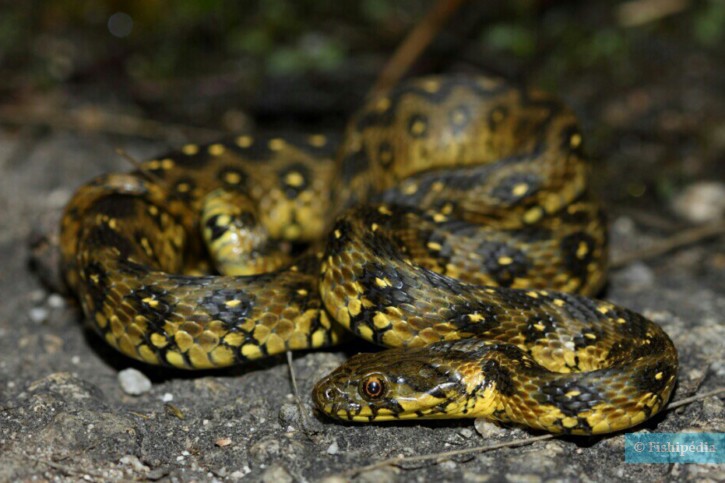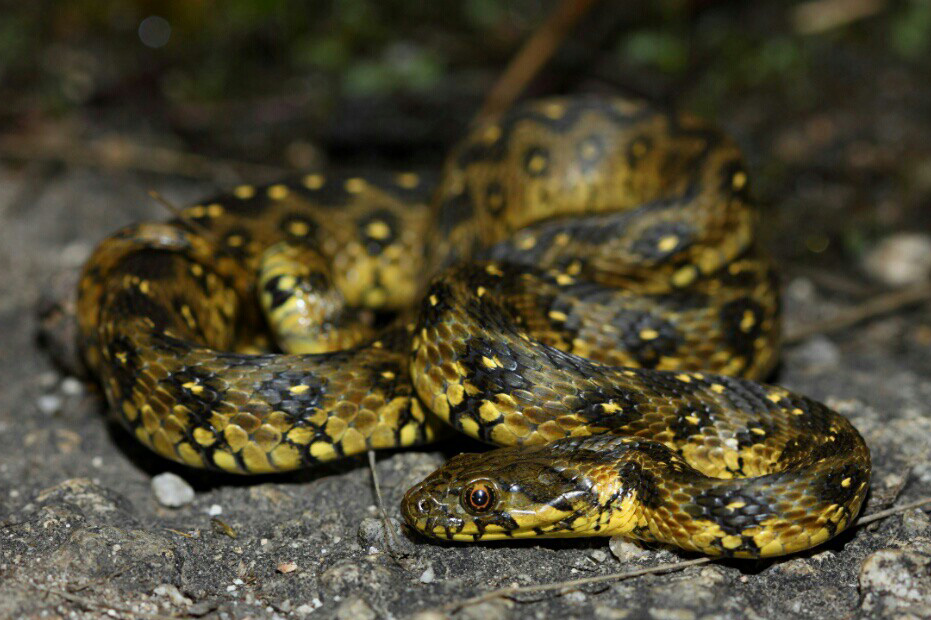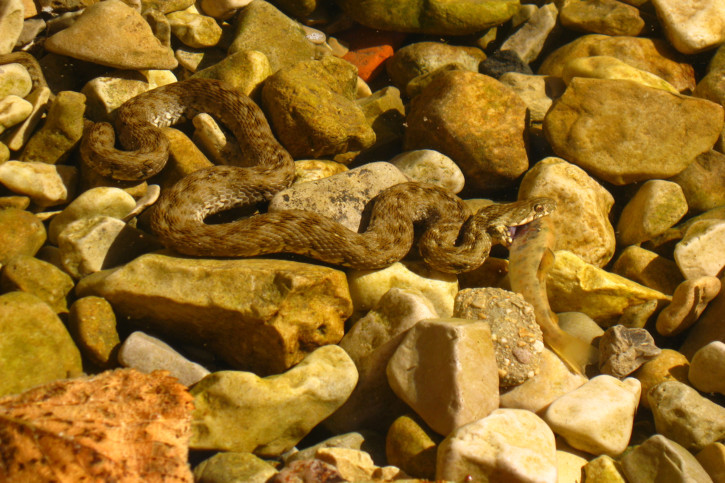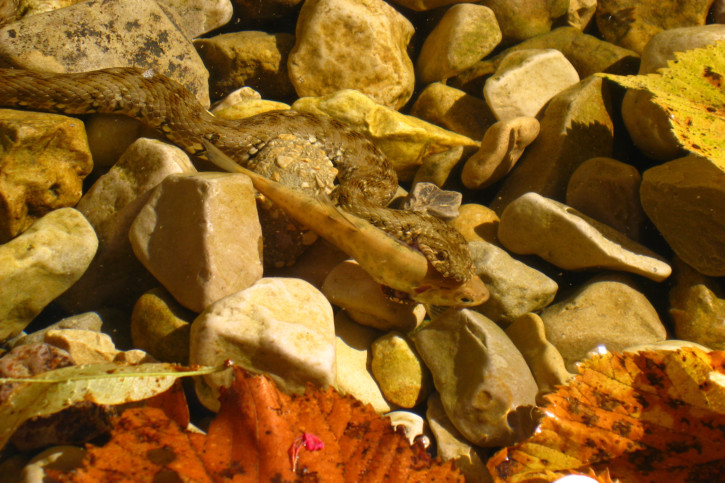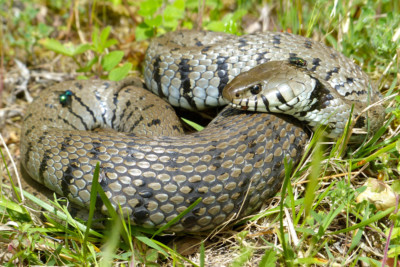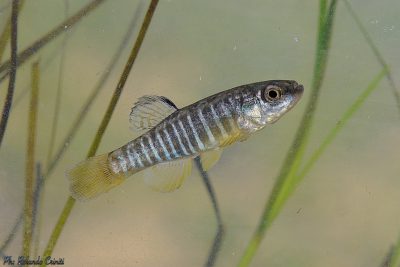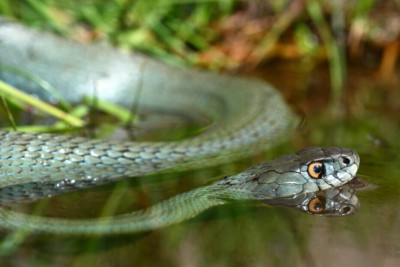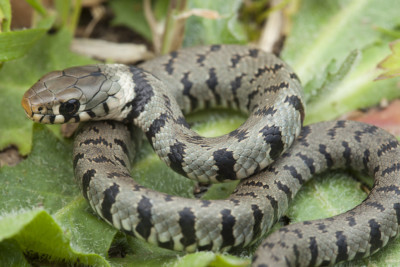Introduction
Natrix maura is an aquatic snake commonly known as the viperine snake because of its resemblance to vipers. This resemblance has long worried swimmers. Even today it is sometimes mistaken by those unfamiliar with it. But like all snakes, this species is not venomous. It can be found throughout the entire western Mediterranean region.
Who is it?
Morphology
-
Type
-
Female size55 - 90 cm
-
Male size45 - 80 cm
-
Motiftasks
-
Mimicryplants
-
Longevity25 year
-
Type
-
Female size55 - 90 cm
-
Male size45 - 80 cm
-
Motiftasks
-
Mimicryplants
-
Longevity25 year
How to recognize This reptile ?
The viperine snake is recognizable by its keeled scales, olive-brown color on the dorsal part, and two series of black oval marks with a lighter area in the middle. Its belly is yellowish to orangish, also dotted with black spots.
Natrix maura is the smallest of the genus, with certain species reaching up to 140 centimeters like the helvetic snake (Natrix helvetica).
Sexual dimorphism
Like other Natrix snakes, the female is larger, reaching 90 centimeters compared to 80 for the male. The females have a larger head and shorter tail.
Behaviour & Life cycle
-
Sociabilitysolitary
-
Way of livingdiurnal
-
VenomousNo
-
Dietpredator
This snake never strays far from the humid environments of meadows and wooded areas: riverbanks, ponds, marshes. Its diet is less specialized than the grass snake. In some regions, it mainly feeds on frogs, toads, and tadpoles, like the grass snake. However, in other populations, they specialize in fishing for fish. Juveniles feed on smaller prey such as earthworms and slugs.
This species spends most of its time in solitude, but it is not aggressive towards its conspecifics. After the grass snake, it is one of the most aquatic snakes in Europe.
Reproduction occurs during mass gatherings of males and females. The viperine snake hibernates from autumn to spring. It can be found coiled up in various hiding spots: underground holes, tree stumps, vegetation... Despite its mimicry with its environment, it is also preyed upon by waders, other snakes, birds of prey, and mammals.
Reproduction
-
Reproductionovipare qui pond sur substrat caché
-
Clutch size5 - 30 eggs
Like other Natrix snakes, males and females gather in spring in suitable reproduction habitats, i.e., warm and humid areas (vegetation, roots, etc.). Generally, only the largest males manage to mate.
Females may lay eggs in the mating location if conditions are favorable. They may sometimes dig a hole to deposit their eggs. Clutches of over 1,000 eggs have been found at the same site.
This can sometimes lead to areas of high concentration of young snakes after hatching. Each yearly clutch usually includes around twenty eggs. They must be kept at around 25°C to mature. Once hatched, the young are left to fend for themselves and must quickly find refuge to escape numerous predators. They display the same patterns as adults. The young are all approximately the same size, regardless of their mother's size.
Harmless species
The viperine snake poses no particular danger to humans when encountered in its natural habitat because it is very timid. Faced with a human, it will always flee without seeking any provocation. It is not venomous and rarely bites, even if stressed or caught.
Origin and distribution
Geographic distribution & Conservation
In Europe, this species ranges from Portugal to Spain, crosses much of France to the extreme southwest of Switzerland and northwest Italy. In Italy, it sometimes coexists with the grass snake. In several countries, it is critically endangered (Switzerland) or nearly threatened (France).
In North Africa, it is present in most of Morocco, northern Algeria, northern and central Tunisia, and northwest Libya.
It is also found on Mediterranean islands: Sardinia (Italy), Corsica, Hyères islands, and Galite. It has been introduced to Minorca and Majorca in the Balearic Islands, where it threatens rare endemic amphibians. On these islands, it is considered harmful and invasive. It can be found up to 2,600 m in altitude.
Conservation status of populations (IUCN)
What is its habitat?
Natural environment characteristics
-
Temperature14 - 30 °C
-
FlowMedium, Slow and Stagnant
Biotope presentation
The viperine snake can be found in all humid environments of meadows and wooded areas. It particularly thrives near stagnant or slow-flowing waters, such as ponds and marshes. But it can also be found in slow-moving waters of rivers and large rivers, in streams and forest ponds.
Species of the same biotope
To go further
Sources & Contributions
Participation & Validation
The Fishipedia team and specialist contributors are committed to providing high-quality content. However, although the information comes from scientific sources or testimonials from specialists, the cards may contain inaccuracies.
Translation
Translation done with the valuable contribution of our translators, who make this information available to a wider audience. We sincerely thank them for their commitment.
Scientific partners
Tags
Same genus
Species of the same biotope
